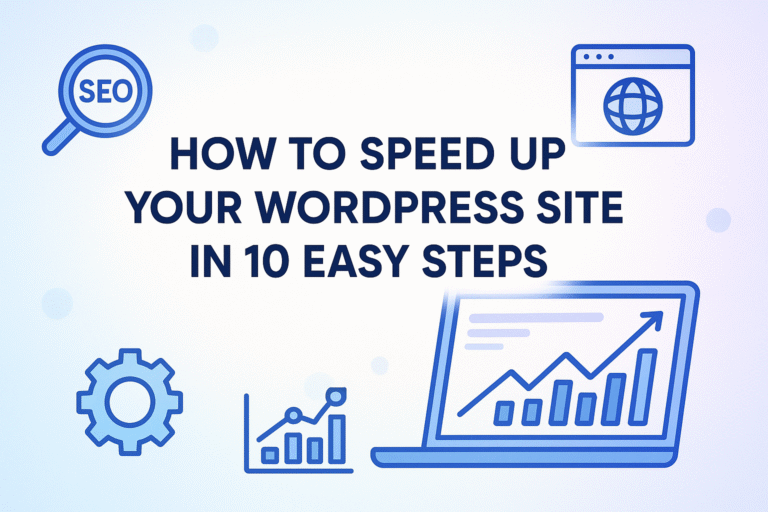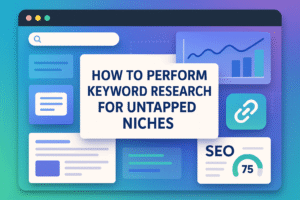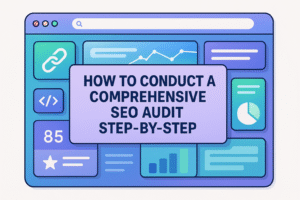In today’s fast-paced digital environment, the speed up your WordPress site is crucial. A slow-loading site not only irritates users but also jeopardizes your search engine rankings. WordPress, a leading content management system, provides numerous methods to boost site performance, yet many users encounter sluggish websites.
Mastering the optimization of your WordPress site is vital for user satisfaction and search engine optimization. With targeted adjustments like selecting a reliable hosting provider and optimizing images, you can markedly enhance page load times. These improvements elevate both user experience and SEO performance, increasing visibility and engagement.
This article presents ten practical steps to significantly accelerate your WordPress site without sacrificing quality. From utilizing caching plugins to enabling GZIP compression, we offer actionable strategies to position your site for the demands of today’s internet users.
Choose a Reliable Hosting Provider
Choosing a reliable hosting provider is essential for speeding up your WordPress site and enhancing overall performance. The hosting provider you select directly affects page load times, which can significantly impact user experience and bounce rates.
There are several types of hosting to consider: shared, VPS, dedicated, and managed WordPress hosting. Managed WordPress hosting, such as services provided by WP Engine, can boost site speeds by up to 68% on average. These services offer optimized environments tailored specifically for WordPress.
The server technology and infrastructure of your hosting environment are crucial for optimizing site speed. Quality hosting providers offer features like automatic caching solutions. For instance, LiteSpeed Cache is a powerful tool that aids in accelerating WordPress sites by handling CSS files and other static content more efficiently.
Here’s a quick comparison of hosting types:
| Type | Performance Level | Cost |
| Shared | Basic | Low |
| VPS | Moderate | Moderate |
| Dedicated | High | High |
| Managed WordPress | Very High | Varies |
Choosing the right hosting plan tailored to your specific needs can improve loading speed and conversion rates, benefiting both users and search engines.
Use a Speed-Optimized, Lightweight Theme
When it comes to speeding up your WordPress site, selecting a speed-optimized, lightweight theme is crucial. A well-coded theme significantly reduces load times and enhances user experience, while feature-heavy, poorly coded themes can bog down your site. Prioritizing speed optimization, along with aesthetics and functionality, is essential when choosing a theme.
Switching to a theme with built-in performance optimization can resolve numerous potential speed-related issues. It is beneficial to research and test themes, ensuring they are fast and efficient. Resources such as WP Rocket’s list of the fastest WordPress themes can be invaluable for this purpose.
To identify performance issues caused by an installed theme, using tools like the Query Monitor plugin can be extremely helpful. This plugin provides insight into how your current theme affects site speed, guiding you to make more informed decisions.
Key Benefits of a Lightweight Theme:
– Reduced Load Times: Faster loading speed enhances user satisfaction and lowers bounce rates.
– Improved User Experience: A quicker site provides a seamless browsing experience.
– Better Search Engine Rankings: Speed is a critical factor for search engine rankings, influencing conversion rates positively.
Choosing a lightweight theme is a foundational step in achieving optimal site performance.
Implement a WordPress Caching Plugin
Implementing a WordPress caching plugin is a highly effective way to speed up your site. Caching reduces load times by storing static copies of your web pages, allowing servers to quickly deliver content to users without processing heavy server requests each time. This enhances user experience and can significantly lower bounce rates.
Two popular caching plugins are W3 Total Cache and WP Super Cache. These plugins decrease server resource usage and improve loading speed by optimizing CSS files, minifying HTML, and enabling browser caching. For enhanced performance, consider using a content delivery network (CDN) to distribute static content globally, minimizing server load.
Here is a table comparing the two plugins:
| Feature | W3 Total Cache | WP Super Cache |
| Minification | Yes | Yes |
| CDN Support | Yes | Yes |
| Easy Setup | Moderate | Easy |
| Advanced Options | Extensive | Basic |
Regular updates and choosing the right caching plugin can significantly boost your site’s performance on Google PageSpeed Insights. It’s crucial for sites with high traffic, especially for mobile users, to maintain quick load speeds to improve SEO and conversion rates.
Optimize and Compress Images
Optimizing and compressing images is crucial for enhancing WordPress site speed. Finding the right balance between the smallest file size and acceptable quality impacts performance positively. JPEG, PNG, and WebP are popular image file formats, each offering unique compression methods tailored for different optimization needs.
Lazy loading can significantly enhance loading speed by delaying image loading until they are required. This method prevents all images from being loaded simultaneously, reducing initial loading times and improving user experience.
WP Smush is a powerful image optimization plugin designed to compress images without sacrificing quality. By reducing file sizes, WP Smush facilitates faster load times, improving overall site performance. Similarly, tools like Imagify automatically optimize images, including thumbnails, upon upload to WordPress, ensuring ongoing efficiency.
Here’s a quick checklist for image optimization:
- Choose the right file format: JPEG for photos, PNG for graphics, and WebP for new-generation compression.
- Implement lazy loading to enhance load speeds.
- Use plugins like WP Smush or Imagify for automatic image compression.
Optimizing and compressing images not only enhances WordPress site speed but also improves Core Web Vitals, leading to better search engine rankings and user satisfaction.
Enable Lazy Loading for Media
Implementing lazy loading for media on your WordPress site can significantly enhance performance by reducing initial page load times. Lazy loading delays the loading of media elements such as images, videos, and iframes until they are in the user’s viewport. This means that content lower on the page is deferred until users scroll down, saving valuable bandwidth and speeding up the rendering process.
To activate lazy loading, consider using the Lazy Load by WP Rocket plugin. This tool efficiently manages images and iframes, ensuring they only load when needed. Similarly, the BJ Lazy Load plugin is another popular choice for WordPress users, seamlessly replacing post and Gravatar images with a lazy loading mechanism.
Benefits of Lazy Loading:
– Reduced Load Times: Quicker page rendering by postponing lower-page content.
– Enhanced User Experience: Faster interaction as crucial content loads first.
– Bandwidth Efficiency: Lower data usage, beneficial for mobile users.
| Plugins | Features |
| Lazy Load by WP Rocket | Efficient image and iframe management |
| BJ Lazy Load | Replaces post and gravatar images |
Incorporating lazy loading not only invigorates performance on media-heavy sites but also improves user experience, ultimately contributing to better search engine rankings due to faster load speeds.
Minify CSS, HTML, and JavaScript Files
Minifying CSS, HTML, and JavaScript files is an essential step in optimizing your WordPress site for better performance. This process involves removing unnecessary elements like whitespace, comments, and punctuation, resulting in smaller files that load faster. Minification does not affect the visual or functional aspects of your site but significantly enhances loading speed.
Tools such as WP Rocket and online services like minifier.org automate this process, ensuring efficient minification of your site’s CSS, HTML, and JavaScript. Plugins like Autoptimize and WP Minify also offer seamless integration with WordPress, combining and compressing these files for improved optimization.
Key Benefits of Minification:
– Reduces File Size: Strips out extra spaces and unnecessary code.
– Improves Load Times: Decreases the amount of data sent to browsers.
– Enhances User Experience: Faster loading sites improve user engagement and reduce bounce rates.
– Boosts Search Engine Rankings: Speedy sites are favored by search engines.
Incorporating minification can tackle performance issues on your site, leading to better load speeds, especially for mobile users. Regularly updating your minification plugins and tools is crucial to maintaining optimal site performance.
Use a Content Delivery Network (CDN)
Implementing a Content Delivery Network (CDN) is a powerful way to speed up your WordPress site, especially if you cater to a global audience. A CDN consists of an interconnected system of geographically distributed servers that deliver web content more efficiently. By serving data from the server closest to the user, a CDN significantly reduces latency and shortens load times.
CDNs store copies of your site’s static content, such as images and HTML files, and distribute them across multiple servers. This approach ensures that all users, regardless of their location, enjoy a fast and consistent user experience.
For WordPress sites, integrating a CDN can complement existing caching plugins, thereby ensuring even swifter loading speeds and potentially boosting SEO rankings. Moreover, using a CDN can help lessen the load on your main hosting server, freeing up server resources for dynamic content processing.
Key Benefits of Using a CDN:
– Faster load times by reducing data travel distance
– Consistent performance for users worldwide
– Enhanced search engine optimization (SEO)
– Reduced load on your main hosting server
Implementing a CDN not only enhances user experience and performance but can also positively impact your site’s bounce rate and conversion rate.
Regularly Update WordPress, Plugins, and Themes
Regularly updating WordPress, including its core, themes, and plugins, is essential for optimizing site performance and enhancing security. Updates often contain performance improvements, bug fixes, and compatibility enhancements that can significantly speed up a WordPress site and boost its efficiency.
Key Benefits of Regular Updates:
– Performance Improvements: Latest features and optimizations for better site speed.
– Security Enhancements: Protection against vulnerabilities and exploits.
– Bug Fixes: Resolution of issues that might cause sluggishness or errors.
Best Practices:
- Test Updates: Use a staging environment to check for potential conflicts before going live.
- Enable Auto-Updates: For minor WordPress core upgrades to ensure the site remains updated with minimal effort.
- Stay Current: Maintain the latest versions of WordPress, PHP, and HTML for optimal performance and security.
| Update Component | Importance |
| WordPress Core | Essential for site stability and speed |
| Themes | Required to incorporate design improvements |
| Plugins | Needed for functionality and security |
Updating regularly is a simple yet powerful action to improve loading speed, enhance user experience, and keep your site appealing to search engines and mobile users alike.
Clean and Optimize Your Database
To enhance your WordPress site’s performance, cleaning and optimizing your database can be essential. Using a plugin like WP-DB Manager or WP-Optimize simplifies this process significantly. Before diving into optimization, always back up your data to prevent any accidental disruptions to your website.
Database optimization involves several crucial tasks, such as removing old post revisions, deleting trashed comments, and cleaning up expired transient options. These actions can improve the efficiency and speed of your WordPress site. WP-Optimize is particularly useful as it not only provides options for database cleanup but also includes features for caching and image compression.
While you can manually clean your database using phpMyAdmin, it’s risky and best suited for individuals with technical expertise. A safer approach is to use dedicated plugins that streamline the process, ensuring your site remains functional.
Database Optimization Steps:
- Backup Your Data: Essential for risk mitigation.
- Use a Plugin: Install WP-DB Manager or WP-Optimize.
- Clean Up: Remove post revisions, trashed comments, and expired transient options.
By taking these measures, you can enhance your site’s loading speed and user experience effectively.
Eliminate Render-Blocking JavaScript and CSS
Improving the load speed of your WordPress site is crucial for enhancing user experience and increasing your site’s performance on search engines. Render-blocking JavaScript and CSS files delay webpage display until fully loaded, negatively impacting the time to first render. To tackle this, prioritize critical CSS for above-the-fold content and load additional CSS asynchronously or after the page is fully loaded.
Utilizing plugins like WP Rocket, WP Meteor, Flying Scripts, Plugin Organizer, Gonzales, and Perfmatters can effectively defer and delay JavaScript execution, addressing these render-blocking issues. These tools help in loading non-essential scripts later in the page load process, optimizing the site’s performance.
Minifying HTML, CSS, and JavaScript by removing unnecessary characters is another strategy to reduce file sizes. This optimization decreases data transfer times between servers and browsers, further improving loading speeds. By implementing these techniques, you can significantly reduce performance issues and enhance user experience on your WordPress site.
Here’s a quick checklist:
– Prioritize critical CSS
– Load additional CSS asynchronously
– Use plugins like WP Rocket and Perfmatters
– Minify HTML, CSS, and JavaScript
These strategies will help you greatly enhance your site’s load times and overall efficiency.
Reduce HTTP Requests
Reducing HTTP requests is a crucial strategy for speeding up your WordPress site. Each user interaction, such as clicking a link, initiates multiple HTTP requests, which can increase load times and server strain. By minimizing these requests, you simplify the browser’s task of rendering the webpage, improving user experience and load speed.
One effective way to reduce HTTP requests is by combining multiple CSS or JavaScript files into fewer files. This approach decreases the number of files the server needs to retrieve, thereby enhancing the site’s performance. Additionally, minimizing external HTTP requests can be achieved by disabling unnecessary scripts and styles or merging them into a single file.
Here’s a brief list of strategies to reduce HTTP requests:
– Combine CSS and JavaScript files.
– Disable unused external scripts.
– Merge styles and scripts into a single file.
By implementing these tactics, you not only reduce server load but also improve your site’s loading speed, which is favorable for both users and search engines. This optimization can lead to better Core Web Vital scores and ultimately improve your site’s conversion rate.
Enable GZIP or Brotli Compression
Enabling GZIP or Brotli compression can drastically enhance your WordPress site’s speed by reducing file sizes by up to 70%. This leads to faster download times and lower bandwidth consumption. Most quality hosting providers automatically enable these compressions at the server level, which is the most efficient way to boost site speed.
For those who need to set it up manually, GZIP compression can be enabled by adding specific directives to server configuration files such as .htaccess for Apache or nginx.conf for Nginx.
Here’s a quick overview:
| Compression Type | Server Configuration File |
| GZIP | .htaccess (Apache) |
| Brotli | nginx.conf (Nginx) |
Additionally, many WordPress optimization plugins, like WP Super Cache and W3 Total Cache, enable you to implement GZIP compression with just a few clicks. Once activated, verify its effectiveness to ensure your site achieves faster load times.
In summary, enabling GZIP or Brotli compression is a vital step that optimizes your WordPress site’s loading speed and improves overall user experience.




